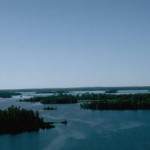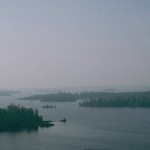Voyageurs National Park and the Boundary Waters Canoe Area Wilderness are better known for pristine wilderness than they are poor air quality. Yet both have become the focus of a regional haze plan developed by the Minnesota Pollution Control Agency (MPCA).
The development of the plan was mandated by the U.S. EPA to address impaired visibility in the nation’s largest national parks and wilderness areas. In Minnesota, that includes the BWCAW and Voyageurs. As Stephanie Hamphill recently reported on Minnesota Public Radio, “On the clearest days in the Boundary Waters, you can see 120 miles. But on one-fifth of the days in any given year, you can only see 33 miles. That’s haze getting in the way.”
Photos from Kabetogama State Forest Vista in Voyageurs National Park show visibility fluctuations (courtesy Voyageurs National Park Association and the Historical Photographic Archive).
The regional haze plan is intended to return Voyageurs and the BWCAW to natural air quality conditions by 2064 by addressing emissions sources that may not have been fully managed by the Clean Air Act. In Minnesota, much of this air pollution comes from Taconite plants that have not been retrofitted with pollution control technologies.
The MPCA recently released a revised version of its plan, which was initially released during the spring of 2008. According to the MPCA, revisions include the consideration of Best Available Retrofit Technology (BART) installations for existing plants. Some environmental groups, however, continue to raise concerns that the plan does not address the use of new retrofit technologies. Voyageurs National Park Association, the Friends of the Boundary Waters Wilderness and the Minnesota Center for Environmental Advocacy have all been actively involved in the review process.
The Regional Haze Plan is available HERE for public comment until September 3.



